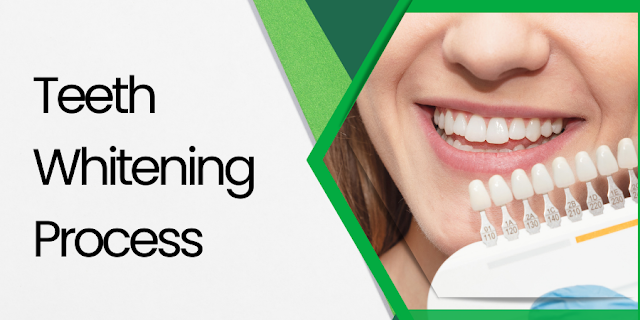Teeth whitening is a cosmetic dental procedure designed to lighten the color of your teeth and remove stains and discoloration. There are various methods for teeth whitening, ranging from at-home treatments to professional dental procedures. Here's an overview of the teeth whitening process:
 |
| Teeth Whitening Process |
Dental Examination: Before undergoing teeth whitening, it's advisable to schedule a dental examination to ensure your teeth and gums are healthy. Your dentist will check for any dental issues that may need to be addressed before whitening.
Choosing a Method:
a. In-Office Whitening: This is a professional teeth whitening procedure performed by a dentist. It typically involves a high-concentration whitening gel and a specialized light or laser to accelerate the process. The entire procedure can often be completed in a single appointment, and the results are usually more immediate and dramatic.
b. At-Home Whitening: This method involves using over-the-counter or dentist-prescribed whitening products, such as whitening strips, trays, or gels. At-home treatments are generally milder and take longer to achieve desired results, usually over several days to weeks.
Pre-Treatment Cleaning: If you're having an in-office teeth whitening procedure, your dentist may clean your teeth to remove any surface stains and plaque.
Protective Measures: During in-office whitening, your dentist will take steps to protect your gums, lips, and cheeks from the whitening agent, which can be abrasive. This is usually done by applying a protective barrier or a rubber dam.
Application of Whitening Agent: In an in-office procedure, a high-concentration hydrogen peroxide or carbamide peroxide gel is applied to your teeth. For at-home treatments, you'll apply the whitening product to custom-fitted trays or strips and wear them for a specified period.
Light Activation (Optional): Some in-office procedures use a special light or laser to activate the whitening gel, which can accelerate the whitening process. The light may be used at intervals during the treatment.
Waiting Period: The whitening gel is left on your teeth for a specified amount of time, allowing it to penetrate the enamel and break down stains.
Rinse and Evaluation: Once the designated time has passed, the dentist or patient rinses off the whitening gel, and the results are evaluated. Multiple sessions may be necessary for more significant whitening.
Post-Treatment Sensitivity: Some patients may experience tooth sensitivity after teeth whitening, which is usually temporary. Your dentist may recommend desensitizing toothpaste or gels to alleviate discomfort.
Follow-Up and Maintenance: To maintain your brighter smile, it's essential to practice good oral hygiene, avoid staining substances like tobacco and dark-colored beverages, and follow any post-whitening instructions provided by your dentist.
Teeth whitening can improve the appearance of your smile, but the results may vary depending on the method used and the initial condition of your teeth. Always consult with your dentist to determine the most suitable whitening method for your needs and to ensure your oral health is in good standing before undergoing any teeth whitening procedure.

During in-office whitening, your dentist will take steps to protect your gums, lips, and cheeks from the whitening agent, which can be abrasive. This is usually done by applying a protective barrier or a rubber dam.
ReplyDelete